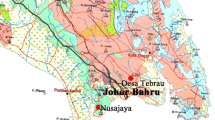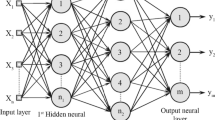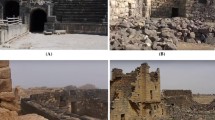Abstract
Application of back-propagation (BP) artificial neural network (ANN) as an accurate, practical and quick tool in indirect estimation of uniaxial compressive strength (UCS) of rocks has recently been highlighted in the literature. This is mainly due to difficulty in direct determination of UCS in laboratory as preparing the core samples for this test is troublesome and time-consuming. However, ANN technique has some limitations such as getting trapped in local minima. These limitations can be minimized by combining the ANNs with robust optimization algorithms like particle swarm optimization (PSO). This paper gives insight into development of a hybrid PSO–BP predictive model of UCS. For this reason, dataset comprising the results of 228 laboratory tests including dry density, moisture content, P wave velocity, point load index test, slake durability index and UCS was prepared. These tests were conducted on 38 sandstone samples which were taken from two excavation sites in Malaysia. Findings showed that PSO–BP model performs well in predicting UCS. Nevertheless, to compare the prediction performance of the PSO–BP model, the UCS is predicted using ANN-based PSO and BP models. The correlation coefficient, R, values equal to 0.988 and 0.999 for training and testing datasets, respectively, suggest that the PSO–BP model outperforms the other predictive models.







Similar content being viewed by others
References
Bieniawski ZT (1974) Estimating the strength of rock materials. J S Afr Inst Min Metall 74:312–320
Armaghani DJ, Mohamad ET, Hajihassani M, Yagiz S, Motaghedi H (2015) Application of several non-linear prediction tools for estimating uniaxial compressive strength of granitic rocks and comparison of their performances. Eng Comput. doi:10.1007/s00366-015-0410-5
Armaghani DJ, Mohamad ET, Momeni E, Monjezi M, Narayanasamy MS (2016) Prediction of the strength and elasticity modulus of granite through an expert artificial neural network. Arab J Geosci. doi:10.1007/s12517-015-2057-3
Gokceoglu C, Zorlu K (2004) A fuzzy model to predict the unconfined compressive strength and modulus of elasticity of a problematic rock. Eng Appl Artif Intell 17:61–72
Armaghani DJ, Amin MF, Yagiz S, Faradonbeh RS, Abdullah RA (2016) Prediction of the uniaxial compressive strength of sandstone using various modeling techniques. Int J Rock Mech Min Sci 31(85):174–186
Sulukcu S, Ulusay R (2001) Evaluation of the block punch index test with particular reference to the size effect, failure mechanism and its effectiveness in predicting rock strength. Int J Rock Mech Min Sci 38:1091–1111
Mishra DA, Basu A (2012) Use of the block punch test to predict the compressive and tensile strengths of rocks. Int J Rock Mech Min Sci 51:119–127
Khandelwal M (2013) Correlating P wave velocity with the physico-mechanical properties of different rocks. Pure Appl Geophys 170:507–514
Khandelwal M, Singh TN (2009) Correlating static properties of coal measures rocks with P wave velocity. Int J Coal Geol 79:55–60
Yagiz S (2011) Correlation between slake durability and rock properties for some carbonate rocks. Bull Eng Geol Environ 70(3):377–383
Kahraman S, Gunaydin O, Fener M (2005) The effect of porosity on the relation between uniaxial compressive strength and point load index. Int J Rock Mech Min Sci 42:584–589
Momeni E, Nazir R, Armaghani DJ, Mohamad ET (2015) Prediction of unconfined compressive strength of rocks: a review paper. J Teknol 77(11):43–50
Nazir R, Momeni E, Armaghani DJ, Mohd Amin MF (2013) Prediction of unconfined compressive strength of limestone rock samples using L-type Schmidt hammer. Electr J Geotech Eng 18:1767–1775
Young Y, Rosenbaum SM (2002) The artificial neural network as a tool for assessing geotechnical properties. Geotech Geol Eng 20:149–168
Singh VK, Singh D, Singh TN (2001) Prediction of strength properties of some schistose rocks from petrographic properties using artificial neural networks. Int J Rock Mech Min Sci 38(2):269–284
Sonmez H, Tuncay E, Gokceoglu C (2004) Models to predict the uniaxial compressive strength and the modulus of elasticity for Ankara Agglomerate. Int J Rock Mech Min Sci 41(5):717–729
Rezaei M, Majdi A, Monjezi M (2012) An intelligent approach to predict unconfined compressive strength of rock surrounding access tunnels in longwall coal mining. Neural Comput Appl 24(1):233–241
Mishra DA, Basu A (2013) Estimation of uniaxial compressive strength of rock materials by index tests using regression analysis and fuzzy inference system. Eng Geol 160:54–68
Liang M, Mohamad ET, Faradonbeh RS, Armaghani DJ, Ghoraba S (2016) Rock strength assessment based on regression tree technique. Eng Comput 32(2):343–354
Meulenkamp F, Grima MA (1999) Application of neural networks for the prediction of the unconfined compressive strength (UCS) from Equotip hardness. Int J Rock Mech Min Sci 36(1):29–39
Rezaei H, Nazir R, Momeni E (2016) Bearing capacity of thinwalled shallow foundations: an experimental and artificial intelligence-based study. J Zhejiang Univ Sci A 17:273–285
Yilmaz I, Yuksek AG (2008) An example of artificial neural network (ANN) application for indirect estimation of rock parameters. Rock Mech Rock Eng 41(5):781–795
Jayraj Singh AK, Verma Haider Banka, Singh TN, Maheshwar Sachin (2016) A study of soft computing models for prediction of longitudinal wave velocity. Arab J Geosci 9(3):1–11
Verma AK, Singh TN (2013) A neuro-fuzzy approach for prediction of longitudinal wave velocity. Neural Comput Appl 22(7–8):1685–1693
Ghoraba S, Monjezi M, Talebi N, Armaghani DJ, Moghaddam MR (2016) Estimation of ground vibration produced by blasting operations through intelligent and empirical models. Environ Earth Sci 75(15):1137
Verma AK, Singh TN (2012) Comparative analysis of intelligent algorithms to correlate strength and petrographic properties of some schistose rocks. Eng Comput 28:1–12
Yagiz S, Sezer EA, Gokceoglu C (2012) Artificial neural networks and nonlinear regression techniques to assess the influence of slake durability cycles on the prediction of uniaxial compressive strength and modulus of elasticity for carbonate rocks. Int J Numer Anal Methods Geomech 36(14):1636–1650
Monjezi M, Baghestani M, Faradonbeh RS, Saghand MP, Armaghani DJ (2016) Modification and prediction of blast-induced ground vibrations based on both empirical and computational techniques. Eng Comput. doi:10.1007/s00366-016-0448-z
Abad SV, Yilmaz M, Armaghani DJ, Tugrul A (2016) Prediction of the durability of limestone aggregates using computational techniques. Neural Comput Appl. doi:10.1007/s00521-016-2456-8
Mohamad ET, Faradonbeh RS, Armaghani DJ, Monjezi M, Majid MZA (2016) An optimized ANN model based on genetic algorithm for predicting ripping production. Neural Comput Appl. doi:10.1007/s00521-016-2359-8
Eberhart RC, Shi Y (1998) Evolving artificial neural networks. In: Proceedings of the international conference on neural networks and brain, pp PL5–PL13
Khandelwal M, Armaghani DJ (2016) Prediction of drillability of rocks with strength properties using a hybrid GA-ANN technique. Geotech Geol Eng 34(2):605–620
Adhikari R, Agrawal RK (2011) Effectiveness of PSO based neural network for seasonal time series forecasting. In: Proceedings of the Indian International Conference on Artificial Intelligence (IICAI) Tumkur, India, pp 232–244
ISRM (2007) In: Ulusay and Hudson (eds) The complete ISRM suggested methods for rock characterization, testing and monitoring: 1974–2006. Suggested methods prepared by the commission on testing methods, International Society for Rock Mechanics
Specht DF (1991) A general regression neural network. IEEE Trans Neural Netw 2(6):568–576
Bounds DG, Lloyd PJ, Mathew B, Waddell G (1998) A multilayer perceptron network for the diagnosis of low back pain. In: IEEE international conference neural networks, pp 481–489
Momeni E, Nazir R, Armaghani DJ, Maizir H (2015) Application of artificial neural network for predicting shaft and tip resistances of concrete piles. Earth Sci Res J 19(1):85–93
Basheer IA, Hajmeer M (2000) Artificial neural networks: fundamentals, computing, design, and application. J Microbiol Methods 43(1):3–31
Rafiai H, Jafari A (2011) Artificial neural networks as a basis for new generation of rock failure criteria. Int J Rock Mech Min Sci 48(7):1153–1159
Kennedy J, Eberhart RC (1995) Particle swarm optimization. In: Proceedings of IEEE international conference on neural networks (Perth, Australia), IEEE Service Center, Piscataway, pp 1942–1948
Armaghani DJ, Hajihassani M, Mohamad ET, Marto A, Noorani SA (2013) Blasting-induced flyrock and ground vibration prediction through an expert artificial neural network based on particle swarm optimization. Arab J Geosci. doi:10.1007/s12517-013-1174-0
Poli R, Kennedy J, Blackwell T (2007) Particle swarm optimization. Swarm Intell 1(1):33–57
Das MT, Dulger LC (2009) Signature verification (SV) toolbox: application of PSO–NN. Eng Appl Artif Intell 22(4):688–694
Victoire T, Jeyakumar AE (2004) Hybrid PSO–SQP for economic dispatch with valve-point effect. Electr Power Syst Res 71(1):51–59
Hassan R, Cohanim B, De Weck O, Venter G (2005) A comparison of particle swarm optimization and the genetic algorithm. In: Proceedings of the 1st AIAA multidisciplinary design optimization specialist conference, pp 18–21
Ismail A, Jeng DS, Zhang LL (2013) An optimised product-unit neural network with a novel PSO–BP hybrid training algorithm: applications to load–deformation analysis of axially loaded piles. Eng Appl Artif Intell 26(10):2305–2314
Zhang JR, Zhang J, Lok TM, Lyu MR (2007) A hybrid particle swarm optimization–back-propagation algorithm for feedforward neural network training. Appl Math Comput 185(2):1026–1037
Zhang C, Shao H, Li Y (2000) Particle swarm optimisation for evolving artificial neural network. IEEE Int Conf Syst Man Cybern 4:2487–2490
Adhikari R, Agrawal RK, Kant L (2013) PSO based neural networks vs. traditional statistical models for seasonal time series forecasting. In: IEEE 3rd International Advance Computing Conference (IACC), pp 719–725
Babanouri N, Karimi Nasab S, Sarafrazi S (2013) A hybrid particle swarm optimization and multi-layer perceptron algorithm for bivariate fractal analysis of rock fractures roughness. Int J Rock Mech Min Sci 60:66–74
Armaghani DJ, Raja RSNSB, Faizi K, Rashid ASA (2015) Developing a hybrid PSO–ANN model for estimating the ultimate bearing capacity of rock-socketed piles. Neural Comput Appl. doi:10.1007/s00521-015-2072-z
Dehghan S, Sattari GH, Chehreh CS, Aliabadi MA (2010) Prediction of unconfined compressive strength and modulus of elasticity for Travertine samples using regression and artificial neural. Netw Min Sci Technol 20:0041–0046
Rabbani E, Sharif F, Koolivand Salooki M, Moradzadeh A (2012) Application of neural network technique for prediction of uniaxial compressive strength using reservoir formation properties. Int J Rock Mech Min Sci 56:100–111
Ceryan N, Okkan U, Kesimal A (2012) Prediction of unconfined compressive strength of carbonate rocks using artificial neural networks. Environ Earth Sci 68(3):807–819
Shi Y, Eberhart R (1998) Parameter selection in particle swarm optimization. In: Proceedings of the seventh annual conference on evolutionary. Springer, New York, pp 591–600
Christensen JC, Estepp JR, Wilson GF, Russell CA (2012) The effects of day-to-day variability of physiological data on operator functional state classification. Neuro Image 59(1):57–63
Author information
Authors and Affiliations
Corresponding author
Ethics declarations
Conflict of interest
The authors declare no conflict of interest.
Rights and permissions
About this article
Cite this article
Mohamad, E.T., Armaghani, D.J., Momeni, E. et al. Rock strength estimation: a PSO-based BP approach. Neural Comput & Applic 30, 1635–1646 (2018). https://doi.org/10.1007/s00521-016-2728-3
Received:
Accepted:
Published:
Issue Date:
DOI: https://doi.org/10.1007/s00521-016-2728-3




